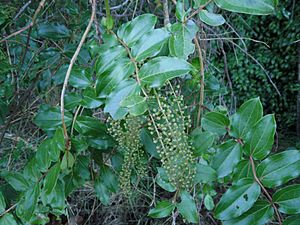Coriaria arborea facts for kids
Quick facts for kids Coriaria arborea |
|
|---|---|
 |
|
| Scientific classification | |
| Genus: |
Coriaria
|
| Species: |
arborea
|
Coriaria arborea is a common native shrub or small tree found in New Zealand. It's also known by its Māori name, tutu. This plant is very poisonous, so it's important to know about it.
Tutu plants grow in open areas and scrubland, from the coast up into the hills. They can grow quite tall, sometimes up to 20 feet (about 6 meters). Their leaves grow in pairs on thin stems. The flowers are arranged in hanging clusters called racemes. C. arborea can also help the soil by adding nitrogen to it.
What Lives on Tutu Plants?
The tutu plant is home to several types of moths that are only found in New Zealand. These include moths like Izatha austera, I. churtoni, I. mesoschista and I. peroneanella.
How People Used Tutu
Even though the tutu plant is poisonous, the Māori found a way to use it safely. They would carefully collect the fleshy flower petals, which are the only part of the plant that isn't poisonous.
They put the gathered berries into special baskets. These baskets were lined with the flower heads of Toetoe plants. This lining acted like a sieve, helping to separate the poisonous seeds from the juice.
The juice they got was used to sweeten foods, like fernroot. Sometimes, they would boil the juice with seaweed. This mixture would then set into a black jelly called Rehia.
Why Tutu is Poisonous
A strong poison called tutin is found in almost all parts of the tutu plant. The only safe part is the fleshy flower petals.
Tutu has caused more cases of livestock poisoning than any other plant in New Zealand. Dogs and even two circus elephants have been poisoned by eating parts of the plant.
Sometimes, people have also gotten sick from honey that was contaminated by tutu. This happens when bees collect honeydew from an insect called the passionvine hopper. This insect feeds on the tutu plant.
In 2014, a man was tramping in Auckland, New Zealand. He thought he saw a plant called supplejack, but he mistakenly tried to eat a young shoot of tutu. He said the taste was terrible, so he didn't actually eat much. However, within hours, he became very ill. He had a serious tonic-clonic seizure that caused his arm to dislocate and made it hard for him to breathe. Experts said he was very lucky to survive. A year later, he had recovered, but he had some trouble with his memory.
Since 1974, there have been several cases of people getting sick from contaminated honey. The most recent cases were in 1991 in the Bay of Plenty and in 2008 in the Coromandel. The risk of poisoning from honey increases during dry periods, like droughts.
See also
In Spanish: Coriaria arborea para niños


